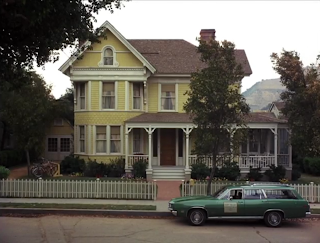Coming up on TCM as part of their Summer Under the Stars tribute to actress Alexis Smith, is one of my favorite Paul Newman films, The Young Philadelphians (1959). Newman plays an up and coming young lawyer, who despite having a respected family name in Philadelphia society, has to work his way up the corporate ladder. Along the way he faces several ethical dilemmas.
As the title suggests, the film is set in Philadelphia, however, the movie was actually filmed in California in Glendale, Pacific Palisades and the Warner Bros. lot in Burbank. Here are the primary filming locations seen in the film.
The film opens with a scene at a church that is supposed to be located on Rittenhouse Square in Philadelphia. There is even a street sign that reads Rittenhouse Square, but I didn't buy that the film crew would have gone to Philadelphia to shoot this scene so I started researching old Los Angeles churches that had a clock tower. I then found a photo of a matching church in the Los Angeles Library collection. Below are two screenshots of the church in the film, a photograph of the church from the 1920s, and an image showing the same modern day location.
Click images to see larger.
The church as seen in the film.
Don't let the street sign fool you. This is no where near Philadelphia's Rittenhouse Square.
Glendale Presbyterian Church. Corner of Harvard and Louise Streets. Photo Credit: LAPL
Current Glendale Presbyterian Church. Corner of Harvard and Louise Streets.
The Glendale Presbyterian Church building that is seen in the film was constructed in 1923, but was destroyed by an earthquake in 1971. There was so much damage that the building had to be demolished and a new building was later built on the same site on top of the existing basement.
Early in the film we see Paul Newman as a young guy managing a construction site. That big hole in the ground was actually on Warner Bros. New York Street backlot. Below you can see a screenshot showing the New York Street set and a modern image of the same set location.
Warner Bros. New York Street backlot used for a Philadelphia construction site.
Warner Bros. New York Street Backlot.
Paul Newman duking it out on WB's New York Street backlot.
Newman's character ends up falling in love with a young socialite played by Barbara Rush. In one scene Newman takes Rush back to her family home. The exterior of the home was actually the Warner Bros. Brownstone Street. These Warner Bros. facades are constantly being changed for project to project and in fact the facade used in the scene below was again being changed out when I took the modern day image.
Warner Bros. Brownstone Street was used for the home of Barbara Rush.
Warner Bros. Brownstone Street as it appears today.
Below is a view of Newman and Rush on Brownstone Street, but looking across to the other side of the street. The facade used during the time of the film has since been completely wiped out. Today this side of the street is the location of the Warner Bros theatre, which does have a facade that can be used for filming - although it now now way resembles the facade which used to be there.
Newman and Rush on Brownstone Street.
The Warner Bros. Theatre now stands on this site of Brownstone Street.
One of the locations in the film is a bar called Ernie's Cocktails. This too was filmed on the Warner Bros. backlot, on New York Street. This facade also has been greatly changed since the film, but you can see below where I've marked with a yellow box, where the Ernie's facade would have been located.
Warner Bros. New York Street was used as the location for Ernie's Cocktails.
The yellow box marks the portion of the facade used as Ernie's Cocktails.
Below is another shot of the Warner Bros. New York Street backlot, this time at Christmas. I love seeing the fake snow on the ground and people wearing heavy jackets. As this is really California - not Philadelphia - I bet it was 80 some degrees at the time.
Warner Bros. New York Street backlot dressed for Christmas time.
The same corner of the New York Street backlot as it appears today.
The next two comparisons show the site of Paul Newman's law office in the film which was also the New York Street backlot.
The Warner Bros. NY Street backlot was used as the exterior for Newman's law office.
The yellow box marks the location of the New York Street backlot exterior used as Newman's law office.
Looking across the street from Newman's office toward the alley.
The WB New York Street backlot. The alley can be seen to the right of the theatre marquee.
This last location is supposed to be the home of the character played by Alexis Smith. In reality, this home is the former Will Rogers Estate, located at 14253 Sunset Boulevard in the Pacific Palisades. The ranch became a State Park in 1944 and today the site includes the 31-room ranch house, a stable, corrals, riding ring, roping arena, golf course, polo field and riding and hiking trails.
Will Rogers House, 14253 Sunset Boulevard, Los Angeles was used as the home of Alexis Smith.
Will Rogers Ranch House. Source
In addition to airing on TCM, The Young Philadelphians is currently available for streaming on Warner Archive Instant and is available on DVD through ClassicFlix. The film, directed by Vincent Sherman, stars Paul Newman, Barbara Rush, Alexis Smith and Robert Vaughn.












































































